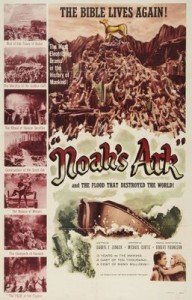The advent of sound was perplexing for the studios, and downright scary for the stars. How would a populace who had never heard them before react to the pitch and intonations of their voices? There were those stars who succeeded in the change to sound (Joan Crawford), some who managed to continue their careers, but at a lesser station (Gloria Swanson), and those whose careers died a quick death (John Gilbert).
An even more interesting part of film history is that brief period when the switch was just getting underway. The sudden appearance of The Jazz Singer changed everything, but everything couldn’t be changed immediately. That’s what I will term hybrid pictures like The Jazz Singer came to be. For though The Jazz Singer is considered the first film with sound, there are only a few scenes which actually have sound through the Warner Brothers Vitaphone process.
Other films which were either partly finished or just recently completed were quickly updated to include a few scenes with the gift of sound to capitalize on the newest technology. One of the other films to be caught up in this frenzy was 1928’s Noah’s Ark.
Noah’s Ark aimed high with a staunchly anti-war message delivered through an interesting approach. Throughout the picture there are two parallel stories which are tied together symbolically and with identical key cast members. The first half or so tells a story of friends caught in the First World War. The second half (actually the last forty minutes or so) take the setting back to the story of the Great Flood.
Well speaking from a purely selfish standpoint, I want to see the Noah story. Nothing against a good World War One yarn, but given the title not what I either expected or signed up for. But perhaps the execution is good, right? I cant always be a gloomy Gus.
So I watched it. All of it. And I wanted to like it.
I really did.
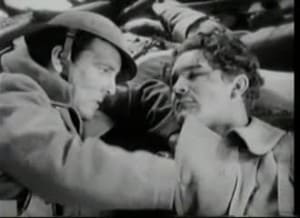 Part of the problem is the doubly split personality of the thing. First we have the two stories, which though both attempt to scratch the same itch both come up lacking. The saga from the War seems overly convoluted (especially given that it doesn’t get the full run time) and I found I didn’t care that much about the twin storylines. We’ve got two pals who enlist (George O’Brien and Guinn Williams) and who have a very “intimate” relationship until one is killed in an assault on one of the Kaiser’s pillboxes. The second part of the World War One scenario is the leering relationship (at least a desired one) between a lecherous communist (Noah Beery) and Mary (Dolores Costello). These to halves of a half (some would say quarter here) are connected by Mary’s marriage to one of the pals above.
Part of the problem is the doubly split personality of the thing. First we have the two stories, which though both attempt to scratch the same itch both come up lacking. The saga from the War seems overly convoluted (especially given that it doesn’t get the full run time) and I found I didn’t care that much about the twin storylines. We’ve got two pals who enlist (George O’Brien and Guinn Williams) and who have a very “intimate” relationship until one is killed in an assault on one of the Kaiser’s pillboxes. The second part of the World War One scenario is the leering relationship (at least a desired one) between a lecherous communist (Noah Beery) and Mary (Dolores Costello). These to halves of a half (some would say quarter here) are connected by Mary’s marriage to one of the pals above.
Sound a bit much? Bingo.
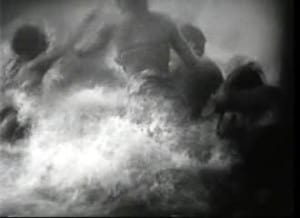 Well how about the Flood piece? Excellent, to say the least. The flood alone is worth the price of admission. Though in the interest of full disclosure the sequence was so dangerous to film that at least one cameraman quit over concerns for the safety of the numerous extras. Sadly, those concerns were rightly placed as several extras did drown and countless more were injured during filming. Just as a random tidbit of trivia, future star John Wayne has always been rumored to be among the countless extras in the grand finale.
Well how about the Flood piece? Excellent, to say the least. The flood alone is worth the price of admission. Though in the interest of full disclosure the sequence was so dangerous to film that at least one cameraman quit over concerns for the safety of the numerous extras. Sadly, those concerns were rightly placed as several extras did drown and countless more were injured during filming. Just as a random tidbit of trivia, future star John Wayne has always been rumored to be among the countless extras in the grand finale.
The downfall of the last forty minutes which contain the Noah-centric content are twofold. First, it is too short and is a much more compelling story than the overwrought and pedantic first two acts. Second, the audience is pretty bored by the time the action turns this way. So much time was spent in 1917 that at least this viewer’s engagement was spent.
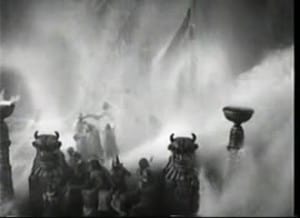 That said, the climactic flood is filled with suspense and drama, with water toppling temples and washing crowds down steps. It is too bad not more of the film centered on this aspect. Perhaps the most importantly is that you can already see director Michael Curtiz’ well developed style already at work. He would later become one of Hollywood’s most prolific directors, with his most frequent collaborators being Errol Flynn and Humphrey Bogart. Though Curtiz had plied his wares for years in Europe, Noah’s Ark is his first American picture. Curtiz’ first directing was done in his native Hungary prior to World War One (in which he served). He later ambled around Europe directing before coming to the States in 1926; where shortly thereafter he was presented with the advent of sound in pictures.
That said, the climactic flood is filled with suspense and drama, with water toppling temples and washing crowds down steps. It is too bad not more of the film centered on this aspect. Perhaps the most importantly is that you can already see director Michael Curtiz’ well developed style already at work. He would later become one of Hollywood’s most prolific directors, with his most frequent collaborators being Errol Flynn and Humphrey Bogart. Though Curtiz had plied his wares for years in Europe, Noah’s Ark is his first American picture. Curtiz’ first directing was done in his native Hungary prior to World War One (in which he served). He later ambled around Europe directing before coming to the States in 1926; where shortly thereafter he was presented with the advent of sound in pictures.
And that leads us to the second piece of division Noah’s Ark gives us. As alluded to earlier, parts of it have sound. Though not by nature a fan of silent films, I found the obvious insertion of a few scenes with spoken dialogue jarringly disruptive. They are relatively typical for the period, with the actors speaking very cleanly and articulately for the mikes. Thought not a natural speech pattern it is typical for this transition period so no issues with that.
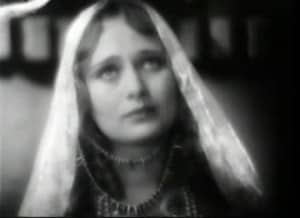 What the few sound scenes do (there were more but were cut after the initial premiere) is further disrupt and already disrupted presentation. The biggest fault with Noah’s Ark is that it simply can’t decide what it wants to be. Although the sound issues are obviously a knee-jerk response to innovations of the day for which the production had no control over, the double entwined plot is murky even with the best glasses. It is this dubious plot mechanism which dooms the picture to a novelty and the added nuisance of the mixed media approach crushes further any rewatchability.
What the few sound scenes do (there were more but were cut after the initial premiere) is further disrupt and already disrupted presentation. The biggest fault with Noah’s Ark is that it simply can’t decide what it wants to be. Although the sound issues are obviously a knee-jerk response to innovations of the day for which the production had no control over, the double entwined plot is murky even with the best glasses. It is this dubious plot mechanism which dooms the picture to a novelty and the added nuisance of the mixed media approach crushes further any rewatchability.
Though caringly restored, Noah’s Ark today should be seen primarily as a milestone in the epic career of a great director with a tremendous finale. Though again, temper that finale with the human cost- which Curtiz would revisit again (though with horses) after the slightly later The Charge of the Light Brigade.
